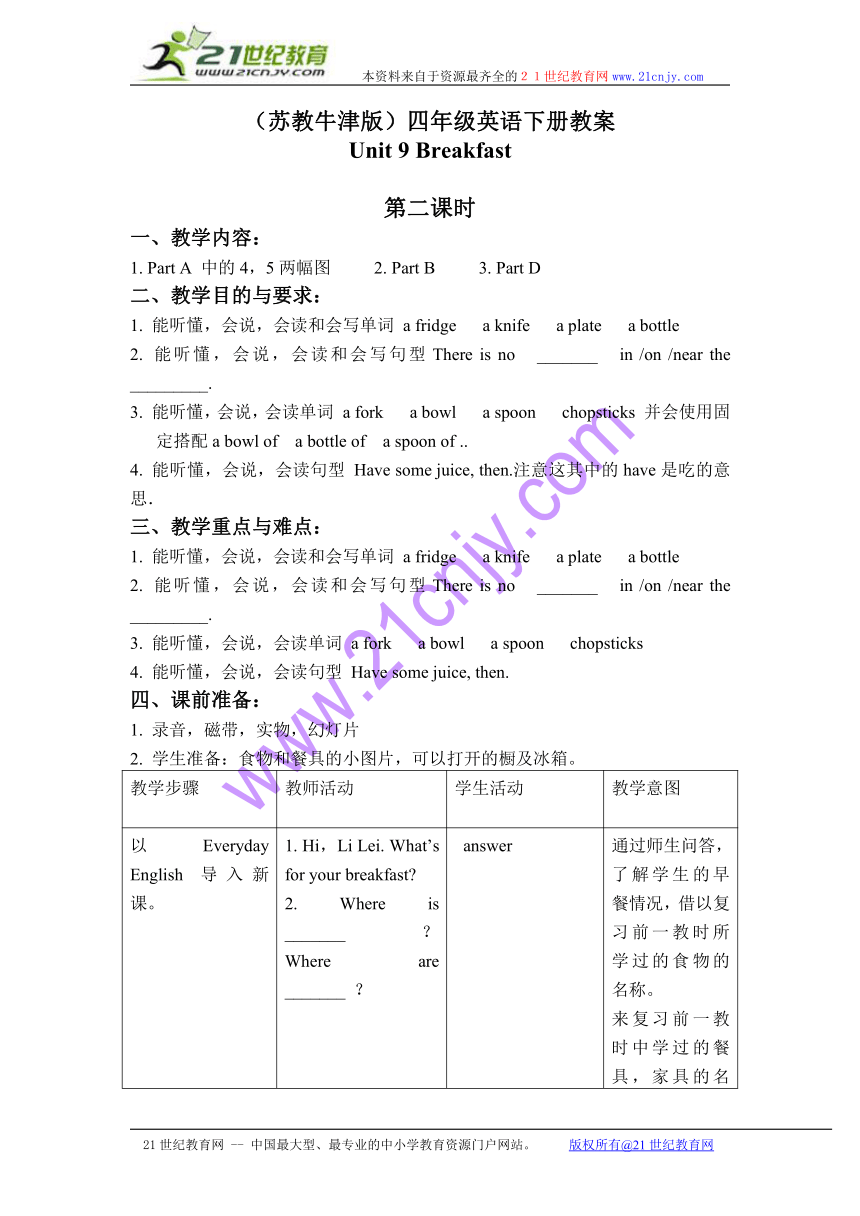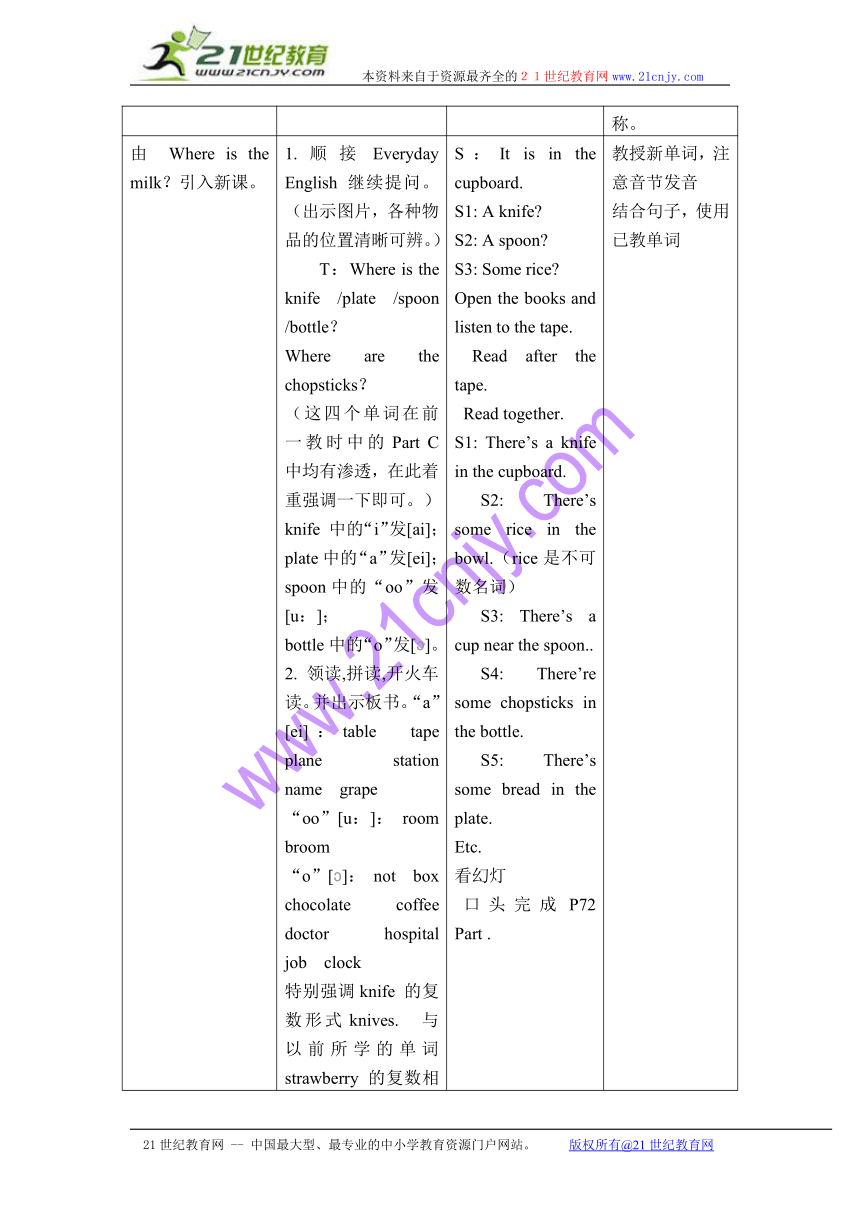四年级英语下册教案 unit 9(4)(苏教牛津版)
文档属性
| 名称 | 四年级英语下册教案 unit 9(4)(苏教牛津版) |  | |
| 格式 | rar | ||
| 文件大小 | 14.1KB | ||
| 资源类型 | 教案 | ||
| 版本资源 | 牛津苏教版 | ||
| 科目 | 英语 | ||
| 更新时间 | 2010-03-03 19:20:00 | ||
图片预览


文档简介
本资料来自于资源最齐全的21世纪教育网www.21cnjy.com
(苏教牛津版)四年级英语下册教案
Unit 9 Breakfast
第二课时
一、教学内容:
1. Part A 中的4,5两幅图 2. Part B 3. Part D
二、教学目的与要求:
1. 能听懂,会说,会读和会写单词 a fridge a knife a plate a bottle
2. 能听懂,会说,会读和会写句型There is no _______ in /on /near the _________.
3. 能听懂,会说,会读单词 a fork a bowl a spoon chopsticks 并会使用固定搭配a bowl of a bottle of a spoon of ..
4. 能听懂,会说,会读句型 Have some juice, then.注意这其中的have是吃的意思.
三、教学重点与难点:
1. 能听懂,会说,会读和会写单词 a fridge a knife a plate a bottle
2. 能听懂,会说,会读和会写句型There is no _______ in /on /near the _________.
3. 能听懂,会说,会读单词 a fork a bowl a spoon chopsticks
4. 能听懂,会说,会读句型 Have some juice, then.
四、课前准备:
1. 录音,磁带,实物,幻灯片
2. 学生准备:食物和餐具的小图片,可以打开的橱及冰箱。
教学步骤 教师活动 学生活动 教学意图
以Everyday English 导入新课。 1. Hi,Li Lei. What’s for your breakfast 2. Where is _______ ? Where are _______ ? answer 通过师生问答,了解学生的早餐情况,借以复习前一教时所学过的食物的名称。来复习前一教时中学过的餐具,家具的名称。
由 Where is the milk?引入新课。 1.顺接Everyday English 继续提问。(出示图片,各种物品的位置清晰可辨。) T:Where is the knife /plate /spoon /bottle?Where are the chopsticks?(这四个单词在前一教时中的Part C 中均有渗透,在此着重强调一下即可。)knife 中的“i”发[ai]; plate中的“a”发[ei];spoon中的“oo”发[u:];bottle中的“o”发[ ]。2. 领读,拼读,开火车读。并出示板书。“a” [ei]:table tape plane station name grape“oo”[u:]: room broom“o”[ ]: not box chocolate coffee doctor hospital job clock特别强调knife 的复数形式knives. 与以前所学的单词strawberry 的复数相结合,重点记忆. 字母a在开音节单词中发它的本音[ei].归纳:“i” [ai]:white pineapple rice right libraryT:Where is the plate?T (Open the cupboard): Oh, yes. It’s in the cupboard. Look! There’re some other things in it What is it (拿出一只碗) Oh, it’s a bowl. A bowl. 领读,拼读,开火车读。 T: Guess, what’s in the bowl T: No.T: No.T: No. Look, it’s a fork. . A fork. Who can use this fork 3. 介绍西餐小知识:吃西餐到底应该哪只手拿knife,哪只手拿fork 反应训练(1)教师说单词,学生举起相应的实物或图片。(2)教师举图片,学生齐说或个别说单词,也可进行比赛。 4. 借助手中的图片,用 There is _______ in /on /near the_______. 来造句。(巩固第八单元句型) T:There’s a fork in the glass.、用Where is the milk? It is _______ . 引入Part D. T: Look! I have a big fridge here. Do you have a fridge home (拿出可打开门的冰箱模型) All right, you all have big fridges home. Read after me “fridge”.领读,拼读,开火车读。注意: “i” [i]. 归类: “i” S:It is in the cupboard.S1: A knife S2: A spoon S3: Some rice Open the books and listen to the tape. Read after the tape. Read together.S1: There’s a knife in the cupboard. S2: There’s some rice in the bowl.(rice是不可数名词) S3: There’s a cup near the spoon.. S4: There’re some chopsticks in the bottle. S5: There’s some bread in the plate. Etc.看幻灯 口头完成P72 Part . 教授新单词,注意音节发音结合句子,使用已教单词
五、练习与巩固:
1. 看板书跟老师齐读。
2. 听录音,模仿跟读Part A. and Part B.
3. 模仿Part A.中的全部五幅画,自编对话。
六、课堂作业:
按要求写词
1) those(反义词) 2) chopstick(复数)
3) where’s(完整形式) 4) sister(对应词)
5) glass(复数) 6) old(反义词)
七、 回家作业:
1. 熟读Part A. and Part B.
2. 抄写并会默写今天所学的四会单词和句型。
3. 书面完成P72 Part D.
八、 板书设计:
a fridgea platea bottlea knife (knives) 主要句型There’s no …in /on /near…a carton of
课后记:此课着重帮助学生了解并掌握不可数名词的量词表示的各种单位,a bowl of, a bottle of, a spoon of, a carton of. 并能与已学不可数名词相配合,注意这种情况的复数形式是在量词后面加上s.同时会用there’s后加no即表示没有.
21世纪教育网 -- 中国最大型、最专业的中小学教育资源门户网站。 版权所有@21世纪教育网
(苏教牛津版)四年级英语下册教案
Unit 9 Breakfast
第二课时
一、教学内容:
1. Part A 中的4,5两幅图 2. Part B 3. Part D
二、教学目的与要求:
1. 能听懂,会说,会读和会写单词 a fridge a knife a plate a bottle
2. 能听懂,会说,会读和会写句型There is no _______ in /on /near the _________.
3. 能听懂,会说,会读单词 a fork a bowl a spoon chopsticks 并会使用固定搭配a bowl of a bottle of a spoon of ..
4. 能听懂,会说,会读句型 Have some juice, then.注意这其中的have是吃的意思.
三、教学重点与难点:
1. 能听懂,会说,会读和会写单词 a fridge a knife a plate a bottle
2. 能听懂,会说,会读和会写句型There is no _______ in /on /near the _________.
3. 能听懂,会说,会读单词 a fork a bowl a spoon chopsticks
4. 能听懂,会说,会读句型 Have some juice, then.
四、课前准备:
1. 录音,磁带,实物,幻灯片
2. 学生准备:食物和餐具的小图片,可以打开的橱及冰箱。
教学步骤 教师活动 学生活动 教学意图
以Everyday English 导入新课。 1. Hi,Li Lei. What’s for your breakfast 2. Where is _______ ? Where are _______ ? answer 通过师生问答,了解学生的早餐情况,借以复习前一教时所学过的食物的名称。来复习前一教时中学过的餐具,家具的名称。
由 Where is the milk?引入新课。 1.顺接Everyday English 继续提问。(出示图片,各种物品的位置清晰可辨。) T:Where is the knife /plate /spoon /bottle?Where are the chopsticks?(这四个单词在前一教时中的Part C 中均有渗透,在此着重强调一下即可。)knife 中的“i”发[ai]; plate中的“a”发[ei];spoon中的“oo”发[u:];bottle中的“o”发[ ]。2. 领读,拼读,开火车读。并出示板书。“a” [ei]:table tape plane station name grape“oo”[u:]: room broom“o”[ ]: not box chocolate coffee doctor hospital job clock特别强调knife 的复数形式knives. 与以前所学的单词strawberry 的复数相结合,重点记忆. 字母a在开音节单词中发它的本音[ei].归纳:“i” [ai]:white pineapple rice right libraryT:Where is the plate?T (Open the cupboard): Oh, yes. It’s in the cupboard. Look! There’re some other things in it What is it (拿出一只碗) Oh, it’s a bowl. A bowl. 领读,拼读,开火车读。 T: Guess, what’s in the bowl T: No.T: No.T: No. Look, it’s a fork. . A fork. Who can use this fork 3. 介绍西餐小知识:吃西餐到底应该哪只手拿knife,哪只手拿fork 反应训练(1)教师说单词,学生举起相应的实物或图片。(2)教师举图片,学生齐说或个别说单词,也可进行比赛。 4. 借助手中的图片,用 There is _______ in /on /near the_______. 来造句。(巩固第八单元句型) T:There’s a fork in the glass.、用Where is the milk? It is _______ . 引入Part D. T: Look! I have a big fridge here. Do you have a fridge home (拿出可打开门的冰箱模型) All right, you all have big fridges home. Read after me “fridge”.领读,拼读,开火车读。注意: “i” [i]. 归类: “i” S:It is in the cupboard.S1: A knife S2: A spoon S3: Some rice Open the books and listen to the tape. Read after the tape. Read together.S1: There’s a knife in the cupboard. S2: There’s some rice in the bowl.(rice是不可数名词) S3: There’s a cup near the spoon.. S4: There’re some chopsticks in the bottle. S5: There’s some bread in the plate. Etc.看幻灯 口头完成P72 Part . 教授新单词,注意音节发音结合句子,使用已教单词
五、练习与巩固:
1. 看板书跟老师齐读。
2. 听录音,模仿跟读Part A. and Part B.
3. 模仿Part A.中的全部五幅画,自编对话。
六、课堂作业:
按要求写词
1) those(反义词) 2) chopstick(复数)
3) where’s(完整形式) 4) sister(对应词)
5) glass(复数) 6) old(反义词)
七、 回家作业:
1. 熟读Part A. and Part B.
2. 抄写并会默写今天所学的四会单词和句型。
3. 书面完成P72 Part D.
八、 板书设计:
a fridgea platea bottlea knife (knives) 主要句型There’s no …in /on /near…a carton of
课后记:此课着重帮助学生了解并掌握不可数名词的量词表示的各种单位,a bowl of, a bottle of, a spoon of, a carton of. 并能与已学不可数名词相配合,注意这种情况的复数形式是在量词后面加上s.同时会用there’s后加no即表示没有.
21世纪教育网 -- 中国最大型、最专业的中小学教育资源门户网站。 版权所有@21世纪教育网
